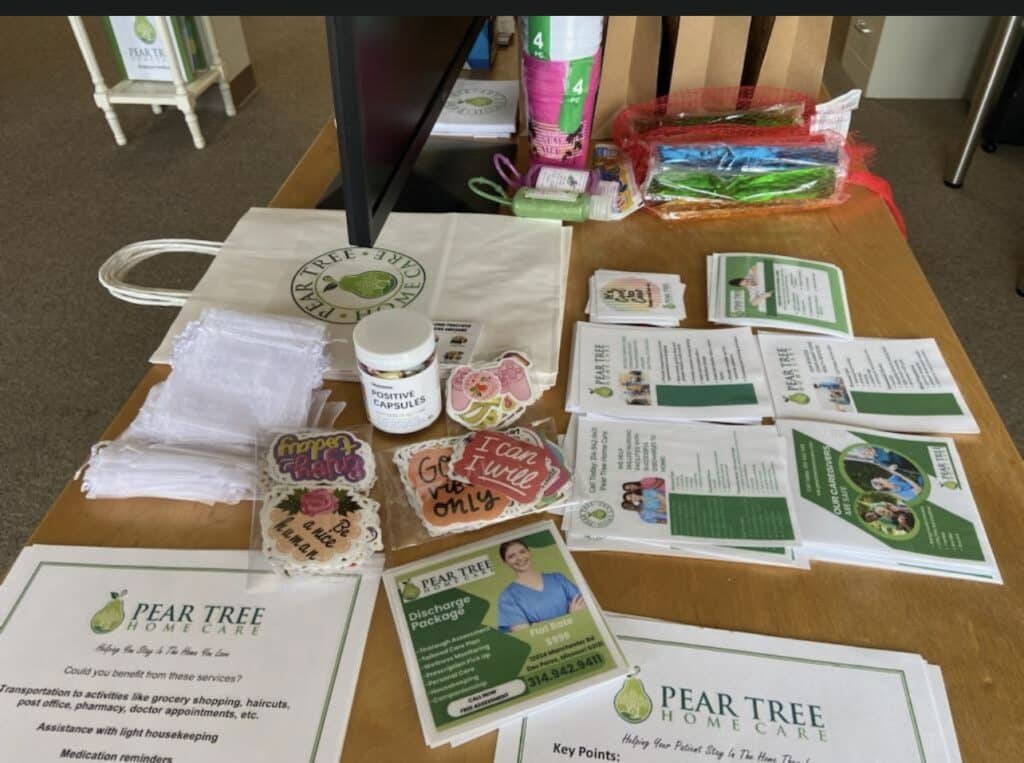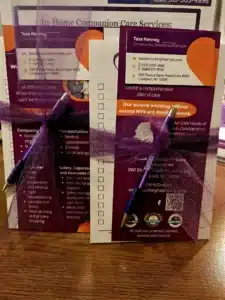In home care sales and marketing, leave-behinds are essential tools that help maintain a connection with potential clients or partners after a meeting ends. These physical materials or items serve as reminders of your services, keeping your brand top of mind. By leaving something tangible behind, you create an opportunity for repeated engagement, ensuring your message continues to resonate long after the initial interaction.

As an expert noted, “Physical items are tangible and can be revisited, making your brand more memorable. They provide an opportunity for deeper engagement with your brand and message” (DOJO Creative).
This makes leave-behinds a powerful asset in your marketing arsenal, particularly in the home care industry, where trust and ongoing relationships are crucial.

Table of Contents
ToggleGuiding Prospects from Awareness to Conversion with Leave-Behinds
Leave-behinds are more than just a token of appreciation; they are strategic tools designed to guide your prospects through the decision-making process.
For a home care community liaison, leaving behind a brochure or a branded item after a meeting can be the difference between being remembered and forgotten. These materials keep your brand visible and relevant, providing the prospect with the information they need when making their decision.
“According to studies, 95 percent of customers choose companies that offer relevant content during every part of the buying process. A great leave-behind is one that provides the information potential customers need, when they need it,” explained one industry expert (IAEE).
By carefully selecting and designing your leave-behinds, you ensure that your message is clear, relevant, and readily accessible when your prospects are evaluating their options.
Selecting the Right Leave-Behind for Maximum Impact
Choosing the right leave-behind involves more than just picking a random promotional item. The key is to select something that aligns with your brand and meets the needs of your target audience.
Traditional Print Materials: Brochures, flyers, and presentation folders are traditional but effective leave-behinds. These materials allow you to provide detailed information about your home care services, making them ideal for follow-up after meetings or at community events.
As one expert put it, “Leave-behinds should be relevant, easy-to-reference, and contain your contact information in an easy-to-find location” (IAEE).
Functional and Everyday Use Items: Practical items like branded pens, notepads, or calendars are great choices because they integrate into the daily lives of your prospects. These items are used regularly, ensuring that your brand remains top of mind. “The higher quality and more useful a product is, the longer a potential customer will use it, and the longer your name will stay in front of them,” advised another expert (Inkwell Printing Company).
Creative and Memorable Leave-Behinds: Sometimes, the most memorable leave-behinds are those that are unique or unexpected. Whether it’s a stress ball shaped to represent your services or a USB drive with your logo, these items stand out and keep your brand in the spotlight.
“Promotional products that are special or unusual enough to be memorable can help differentiate your business from competitors,” said an expert in the field (IAEE).

Crafting Effective Leave-Behinds That Drive Action
The design of your leave-behind is just as important as the item itself. It’s not just about what you leave behind; it’s about how it looks and feels. Consistency in branding across all your materials ensures a professional image and reinforces your brand identity.
An expert emphasizes the importance of storytelling in leave-behinds: “Only 5 percent to 10 percent of people will recall statistics, whereas 65 percent to 75 percent will remember a story. By offering concise, relevant stories in your leave-behind, you can help the reader more easily recall what you can do for them” (IAEE).
This means that incorporating a short narrative about how your services have positively impacted a client’s life can make your leave-behind more engaging and relatable.
Practical design tips include making your leave-behind easy to read, with clear headings and bullet points that highlight the most important information. Using high-quality materials that convey durability and value can reflect positively on your brand, leaving a lasting impression.
Strategic Distribution and Follow-Up for Enhanced Engagement
Once your leave-behind is ready, how and when you distribute it can significantly affect its impact. Distribution should be strategic, whether you’re handing out a brochure after a meeting, offering a branded item at a community event, or including a leave-behind in a direct mail campaign.
But distribution is only part of the process. Following up after distributing a leave-behind is crucial to ensuring it doesn’t just get lost on a desk.
“Leaving your leave-behind with a customer once your service is completed can make sure that a customer remembers you and leads to referrals,” suggested an expert (Inkwell Printing Company).
This follow-up can be as simple as referencing the leave-behind in a follow-up email or call, reinforcing the information and demonstrating that you are proactive and attentive to your prospect’s needs.
Tracking the success of your leave-behinds is also important. Measuring increased inquiries, meetings booked, or conversion rates can provide valuable insights into how well your leave-behinds are performing and help refine your approach.
Learning from Success: Case Studies in Effective Leave-Behinds
Let’s look at a few examples of how leave-behinds have been successfully used in home care sales and marketing.
In one instance, a home care company used customized notepads with daily health tips for seniors. These were distributed at local health fairs and left with potential clients after consultations. The notepads were a hit, not only because they were useful but also because they reinforced the company’s commitment to promoting health and wellness. This led to a noticeable increase in follow-up calls and consultations, directly linked to the leave-behinds.
Another example involves a home care liaison who used a beautifully designed presentation folder filled with testimonials, service details, and a small branded calendar. This folder was given to healthcare providers who might refer clients. The combination of professional design and practical use made the leave-behind stand out, leading to several new partnerships and a steady stream of referrals.
“Even if the client uses your information and they’re done with it, they can use (the USB) for their own stuff, and it still has our logo on it. It keeps us on their mind,” shared one expert who emphasized the long-term impact of practical and reusable leave-behinds (IAEE).
These examples show how the right leave-behind can enhance your marketing efforts and lead to tangible results.

Leave-behinds can be tailored to different market segments by addressing the unique needs of each group. For instance, brochures can be customized with specific information relevant to elderly clients, family caregivers, or healthcare providers.
Effectiveness can be tracked by using unique identifiers like QR codes or promo codes on the leave-behinds. Additionally, monitoring the increase in inquiries, consultations, or referral rates after distributing leave-behinds can provide insights into their success.
Leave-behind materials should be updated regularly, at least quarterly, or whenever significant changes occur in your services or pricing. This ensures that the information provided is always current and relevant.
Digital leave-behinds, such as e-brochures, branded email templates, or downloadable guides, can be used effectively in virtual meetings or sent via email. These digital assets should include interactive elements like videos or links to further resources.
Leave-behinds can be used to reinforce relationships with existing clients by sending thank-you notes, seasonal health tips, or small gifts. This shows ongoing support and can encourage long-term loyalty.
Avoid cluttered designs, overly technical language, or generic content that doesn’t directly address the recipient’s needs. It’s also important to ensure that the quality of the leave-behind reflects the high standards of your services.
Yes, leave-behinds can complement other content marketing efforts by directing recipients to your blog, social media profiles, or online testimonials. This creates a cohesive marketing strategy that connects physical and digital touchpoints.
Valerie VanBooven RN, BSN founded the company after years of working in many different roles from ICU Nurse to Discharge Planner, Home Care, Care Management and more. She wrote her first book in 2003, called “Aging Answers”. After that came “The Senior Solution” in 2009.
Valerie and her staff grew as more home care agencies and senior service businesses realized the undeniable value of being found online.
- Best Home Care Website Design Agencies in 2025 - March 13, 2025
- Home Care Marketing Ideas: The Best Ways to Market Your Home Care Business - September 22, 2024
- Home Care SEO: Strategies for Home Care Website Search Engine Optimization - September 21, 2024



